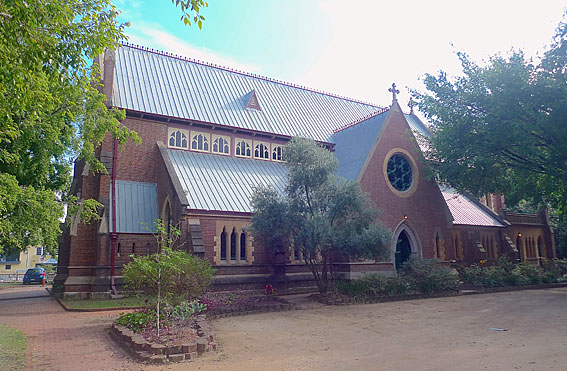
Holy Trinity Anglican Church, Fortitude Valley
[Photograph by Trevor Bunning (July 2015)]

Holy Trinity Anglican Church, Fortitude Valley
[Photograph by Trevor Bunning (July 2015)]
Historical and Technical Documentation by Geoffrey Cox
First & Present Organs © OHTA 2020 (last updated May 2020)
Gallery Organ © OHTA 1989, 2012, 2017 (last updated June 2017)
The present Holy Trinity Church in Fortitude Valley replaced an earlier stone church dating from 1857, and enlarged in 1862. Plans for the new and larger church were put in hand with the arrival of The Revd James Love as Rector in 1875, and the present brick building was opened for worship in July 1877.1 Built in the typical mid-Victorian early English Gothic style, it was designed by the prominent Brisbane architect of the time, F.D.G. Stanley. The chancel and sanctuary were added in 1920-21.2
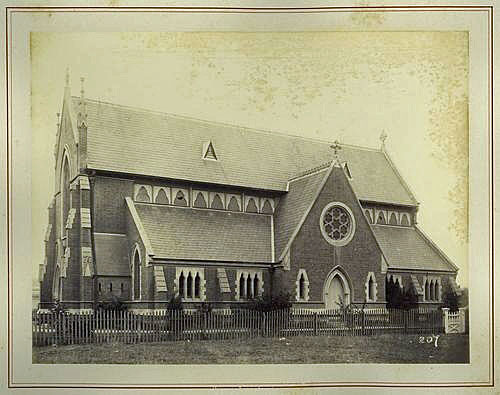
Holy Trinity Church, c.1879, before the additions of 1920-21
[Photograph: John Oxley Library, State Library of Queensland]
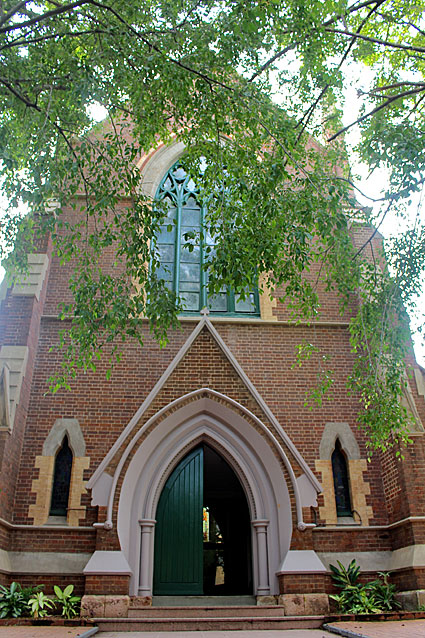
West front of Holy Trinity Church
[Photograph: Trevor Bunning (July 2015)]
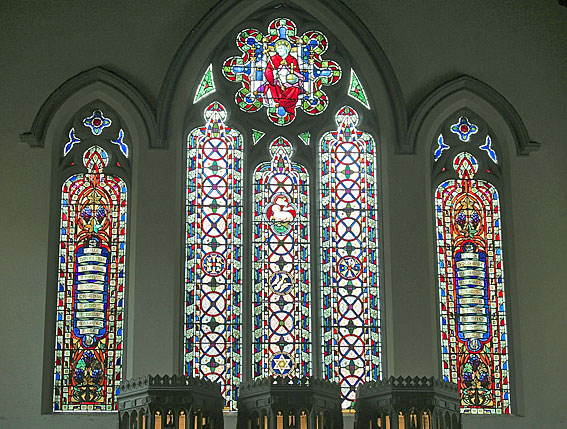
East window of Holy Trinity Church
[Photograph: Trevor Bunning (July 2015)]
First Organ
There were plans for an organ in the original stone church building at Fortitude Valley as early as December 1872, when an 'entertainment' in aid of the organ fund was held.3 An organ was obtained and first used for services on Sunday 15 February 1874.4 A report two days later described the instrument as having eleven draw stops, and as having been 'purchased from' Hill & Son of London:
The new organ in the Fortitude Valley English Church was opened most successfully on Sunday last. The instrument has eleven draw stops, and is, in the opinion of qualified judges, of excellent tone; in fact, in this respect, it is un-surpassed by any organ in Queensland. The instrument was purchased from the eminent firm of W. Hill and Son, London, the builders of the large organ in the Town Hall, Melbourne. The service commenced on Sunday morning at l1 o'clock, the choir singing as a processional hymn No. 136, H. A. M. (the Old Hundredth.) The psalms were well chanted both morning and evening. The Te Deum Laudamus was sung to a setting of this magnificent hymn of praise by Dr. S. S. Wesley. The anthem in the morning was by Macfarren, from the words of the 23rd Psalm, This anthem, as well as the Te Deum, and indeed all musical parts of the service, were admirably sung by the church choir, assisted by personal friends of the organist. In the evening the Magnificat and Nunc Dimittis were sung to the setting of Dr. Arnold, and seemed to be much appreciated. The voluntaries played by the organist were well calculated to display the powers of the organ. We think that the congregation worshipping in the Valley English Church have every reason to congratulate themselves on having secured an excellent organ, while their cordial thanks are due to the choir for the efficient manner in which the musical parts of the service were rendered. We wish Mr. Cox (the organist) every success in his effort to conduct the services of this church in a thoroughly efficient manner; and, considering the present improved circumstances, gratifying results may be anticipated.5
The statement that this instrument was 'purchased from' Hill & Son of London is curious. All subsequent accounts point to the fact that it was built by Timothy Russell of Gray's Inn Road, London, and that the nameplate bore the date 1850.6 It appears, therefore, that the organ was imported second-hand, perhaps through the agency of Hill & Son.
The instrument was moved to the new (present) church at Fortitude Valley in 1877. It was located initially in the gallery, for there are records that it was moved from the gallery to the chancel in 1896 by B.B. Whitehouse of Brisbane.7 This organ was sold to St Paul's Anglican Church, East Brisbane in August 1924 for the sum of £50.8
Present Organ
The present organ at Holy Trinity Church was built in 1909 by B.B.Whitehouse & Co. of Brisbane for the Methodist Church, West End.9 B.B. Whitehouse & Co. offered in February 1908 to build the instrument for the West End church at a cost of £350 (excluding motor), noting that it would incorporate 'spare material' left over following their completion of W.G. Rendall's organ at St Andrew's Presbyterian Church, Brisbane, around this time:
[Mr Archibald stated] that the condition of the choir music was improving and . . . a better instrument was needed. The present organ was certainly a great improvement on the old reed organ, and had materially assisted to bring the church music up to its present pitch. From a musical standpoint it was unable to interpret the true spirit of music. A swell was necessary to secure effects which otherwise it would be impossible to secure. He also stated that St. Andrew's Church organ was built by contract but the contractor went insolvent. The work was completed unsatisfactorily. It has since been altered and the spare material became the property of Whitehouse & Co. Mr Archibald here read an offer by this Company to build an organ for £350, using this spare material . . .
[After some discussion it was moved and seconded] that having heard the statements of Messrs Archibald & Rabbets respecting the proposal to purchase a new organ at a cost not exceeding £375 with motor, or £350 without motor, the trustees approve of the scheme and authorise Messrs Archibald, Rabbets . . . to take the necessary steps to secure the same, on the condition that Messrs Whitehouse & Coy. take over the present organ in part payment at a cost of £100, should we in the meantime have failed to dispose of the same (carried).10
The amount of £100 mentioned at the February meeting was amended in August to read £80.11 The organ was described as being 'under construction' by B.B. Whitehouse & Co. in December 1908,12 and the first payment on the organ was authorised in March 1909.13 The instrument was opened on Wednesday 31 March 1909 with a 'Conversazione' at which special music was provided by the choir, and organ solos by Mr R. J. Archibald.14
By the middle of April 1909, 'Mr Archibald expressed himself as satisfied with the new organ, and that in giving his opinion, that he considered the work had been carried out faithfully and conscientiously.' On the basis of this advise, the balance of payment was approved.15
The instrument served well at West End for some fourteen years, but was then offered for sale to Holy Trinity Church. The first reference to it in the records at Holy Trinity was at the Parochial Council meeting in July 1923:
The Rector (Rev. S. Watkins) announced that he had under offer from Messrs Whitehouse Bros, a 2 manual organ for £850 which was considered to be well worth over £1000. The Rector stated that he had the organ in question thoroughly inspected and was certain that at the price it was an absolute bargain. The Rector presented a photograph of the organ together with specification etc. - the addition of an Electric Blower "& cut off" etc. would cost another £70 making a total of £920 which included cost of erection, overhaul etc.16
Minutes of subsequent meetings show that an organ fund was established immediately, and that steps were taken to sell the old organ.17 The new organ was dedicated by Archbishop Sharp on Sunday 15 June, 1924, and was reported to be free of debt by December that year.18
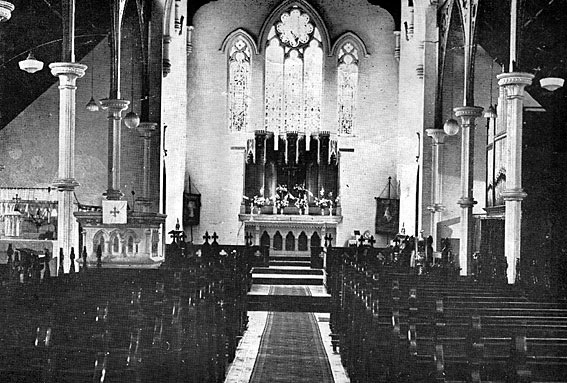
The interior of Holy Trinity Church, 1924,
showing the B.B. Whitehouse & Co. organ installed in that year
[Photograph: Anglican Diocese of Brisbane Records & Archive Centre]
The specification was as follows:
| GREAT Open Diapason Clarabella Dulciana Principal Lieblich Flute SWELL Open Diapason Stop Diapason Salicional Voix Celeste Gemshorn Oboe COUPLERS Swell to Great Swell to Pedal Great to Pedal Swell Super Octave PEDAL Bourdon |
8 8 8 4 4 8 8 8 8 4 8 16 |
Swell tremulant
Attached draw-stop console
Hitchdown-lever swell pedal
Pedalboard: straight and concave
Mechanical action
2 combination pedals to Great Organ
2 combination pedals to Swell Organ
Compass: 58/30.19
The organ was installed at Holy Trinity without any major reconstruction, still retaining its mechanical action. The 'post and rails' casework was very similar to that at St Mary's Catholic Church, Maryborough, although the rails were subsequently removed by when the organ was rebuilt with electric action in 1969.
The Whitehouse organ served for some forty-five years at Holy Trinity before being rebuilt and enlarged with electric action in 1969 by Hill, Norman & Beard of Melbourne (Order nos Q787 & 819). The cost was $13,000, and the whole organ was road-freighted to Melbourne.20 Having originally comprised 12 speaking stops, it was re-dedicated on Sunday 21 December 1969 with a much enlarged specification, in reality derived by extension from just 10 ranks and a mixture.
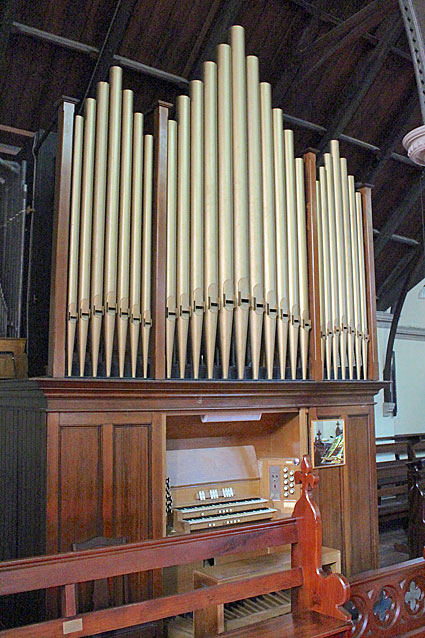
The organ following the rebuild in 1969 by Hill, Norman & Beard of Melbourne
[Photograph by Trevor Bunning (July 2015)]
The original Dulciana 8ft and Voix Celeste 8ft were removed in 1969. The absence of the Dulciana was redressed to some extent in 1996, with the addition by W.J. Simon Pierce of a Great Gamba 8ft. The added stop, which had served previously as a Swell Echo Gamba 8ft at the Presbyterian Church, Coorparoo, was dedicated on 19 May 1996 'in recognition of the outstanding work of Charles Clark as Director of Music from 1965.'21
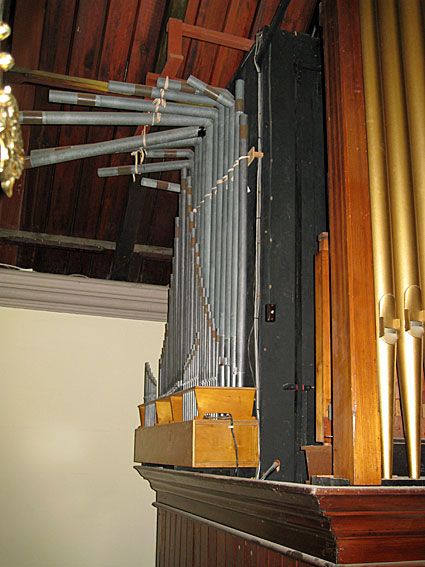
The Gamba 8ft stop added in 1996,
cantilevered outside the existing casework
[Photograph by Geoffrey Cox (July 2011)]
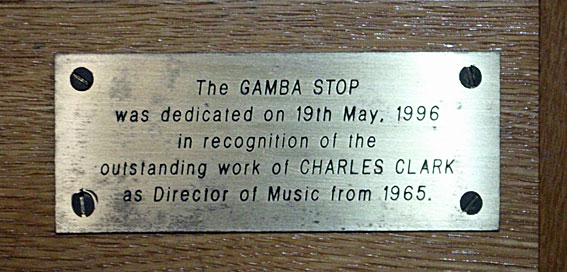
Plaque commemorating the work of Charles Clark as Director of Music
[Photograph by Trevor Bunning (July 2015)]
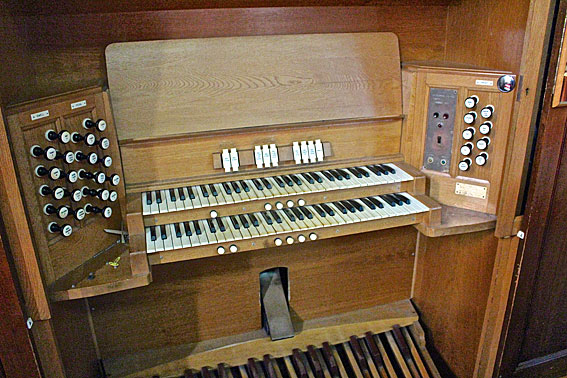
The 1969 console by Hill, Norman & Beard of Melbourne
[Photograph by Trevor Bunning (July 2015)]
The specification is as follows:
| GREAT *Open Diapason *Claribel Flute Gamba *Principal Flute Quint Fifteenth Quartane (19.22) Trumpet SWELL *Open Diapason *Stopped Diapason *Salicional *Gemshorn *Lieblich Flute Block Flute Larigot Cymbale (26.29) Trumpet *Oboe PEDAL *Sub Bass Principal Flute Salicional Octave Octave Flute Super Octave Mixture (26.29) Trumpet Clarion COUPLERS Swell to Great Swell to Pedal Great to Pedal Swell to Great Super Octave Swell to Great Sub Octave Swell Super Octave Swell Sub Octave Swell Unison Off |
8 8 8 4 4 2-2/3 2 II 8 8 8 8 4 4 2 1-1/3 II 8 8 16 8 8 8 4 4 2 II 8 4 |
A B C B B C D E F G F F F D E H A H G A H C D E E |
[1996] [1969] [1969] [1969] [1969, Swell] [Swell] [originally on Great] [1969] [1969] [1969] [1969] [1969] [1969] [1969] [1969] [1969] [1969] [1969] [1969] [1969] |
Tremulant
Attached draw-stop console
Balanced swell pedal
Pedalboard: radiating and concave
Electric action
4 combination pistons to Great and Pedal Organs
4 combination pistons to Swell and Pedal Organs
3 reversible thumb pistons for couplers
Compass: 61/32.22
• stops presumed to originate from the Whitehouse organ of 1909 (West End Methodist ), installed at Holy Trinity, Fortitude Valley in 1924.

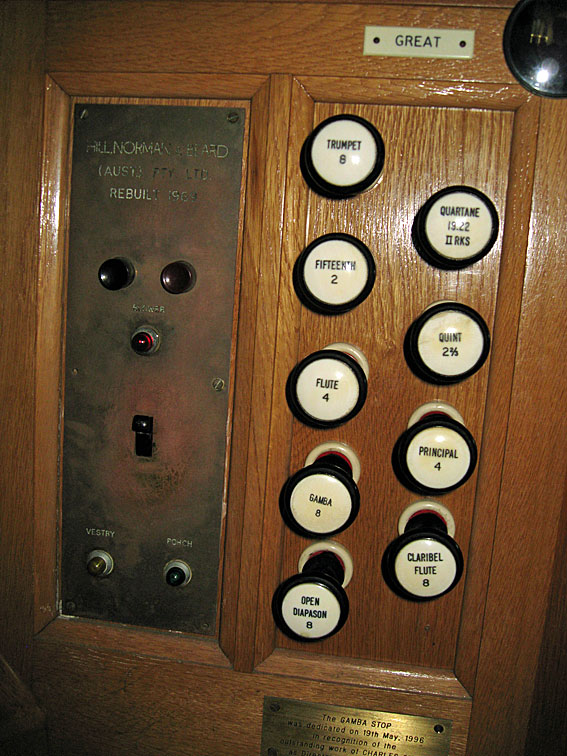
Stop Jambs
[Photographs by Geoffrey Cox (July 2011)]
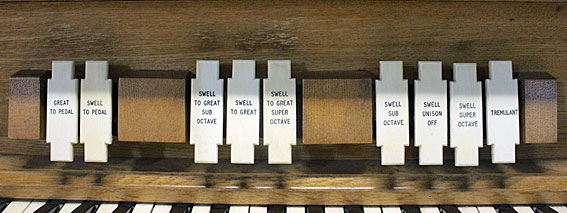
Couplers
[Photograph by Trevor Bunning (July 2015)]
Portable Continuo Organ
The portable continuo organ was built by Knud Smenge of Melbourne in 1982 for Luther College, Croydon, Vic. It was one of four similar chamber organs built by Smenge in that year for locations in Victoria and New South Wales.23 The instrument is almost identical with the Smenge continuo organ now at the Sydney Conservatorium of Music, which is one of the four. The only difference between the two is that the Sydney instrument has a transposing keyboard, whereas the present instrument does not.
The organ was purchased from Luther College in 2003 by the Wangaratta Choristers (since re-named 'Vocal Dimension'), and installed by Wakeley Pipe Organs of Melbourne in Holy Trinity Cathedral, Wangaratta, Vic., from where it served to accompany the choir's performances throughout north-east Victoria and southern New South Wales.24 It was removed to its present location in Brisbane in 2016.

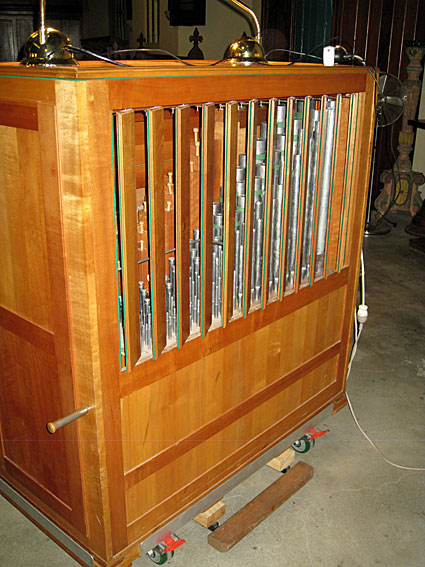
The 1982 Knud Smenge organ at Fortitude Valley
[Photographs by Geoffrey Cox (June 2017)]
The organ sits on a transport trolley, which can be removed, allowing it to rest on its own lockable swivel-wheels. The casework is of Tasmanian Blackwood, with swell shutters at the rear of the instrument operated by a knee lever beneath the manual.
Smenge's organs were all built at A440 and with equal temperament. On arrival in Brisbane, however, the pitch of this instrument was found to have been raised slightly. Further enquiry has revealed that the pitch was adjusted to match that of the Bevington chamber organ in the Lady Chapel at Wangaratta Cathedral.25
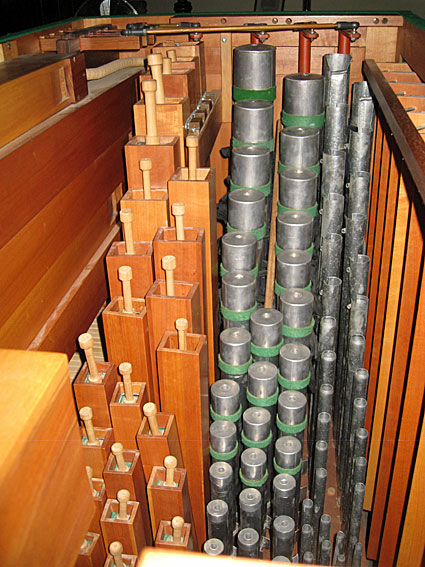
Pipework of the Smenge organ
[Photograph by Geoffrey Cox (June 2017)]
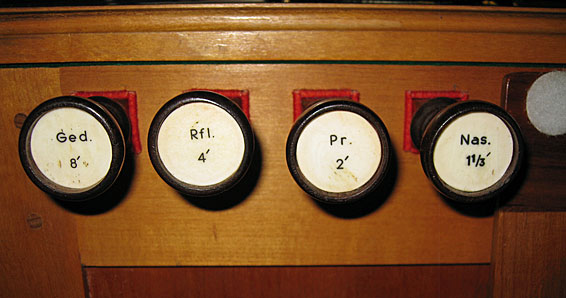
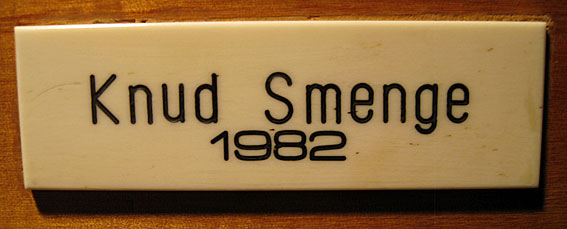
Console details of the Smenge organ
[Photograph by Geoffrey Cox (June 2017)]
| MANUAL Gedackt Rohrflute Principal Nasat |
8 4 2 1-1/3 |
[stopped wood] [metal] [metal; cone-tuned] [metal; from middle c upwards] |
Mechanical action
Compass: 54 notes
No pedals
Knee-operated swell shutters.26
Gallery Organ (Property of John Postle, Esq)
This organ was built by the Positive Organ Co. Ltd, London (Opus 172), probably around 1900. It was one of only two instruments by this maker that reached Queensland, the other being imported in the 1890s for Holy Trinity Anglican Church, Mackay.27 The instrument now at Fortitude Valley was previously at St Joseph's Catholic Church, Kangaroo Point, where it had been installed by Whitehouse Bros in September 1940, together with an electric rotary blower.28 It had been removed around five years earlier from the Catholic Apostolic Church, Manning Street, South Brisbane (which subsequently became St Thomas' Anglican Church).29
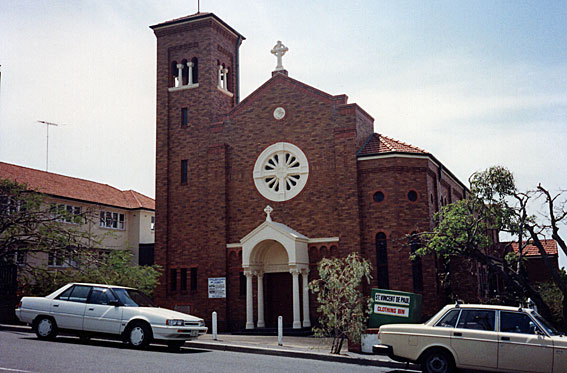
St Joseph's Catholic Church, Kangaroo Point
[Photograph by Howard Baker (October 1989)]
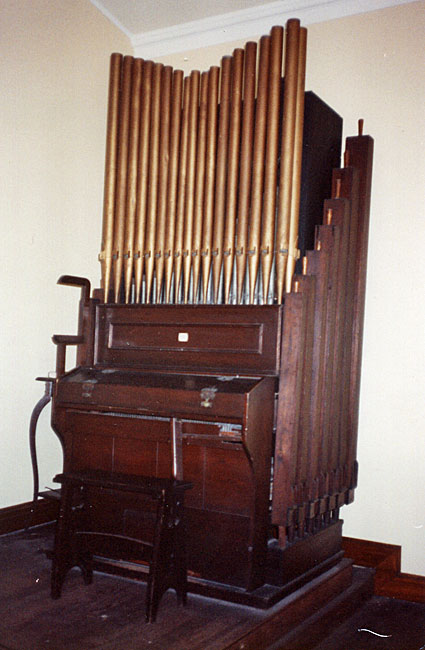
The Positive Organ Co. instrument,
located in the gallery at Kangaroo Point
[Photograph by Howard Baker (October 1989)]
This instrument was purchased in October 1989 by John Postle for his residence in Ashgrove, and overhauled by W.J. Simon Pierce before being installed at Ashgrove in May 1990. In October 1991 it was installed (on loan) in its present location in the gallery of Holy Trinity Church.30
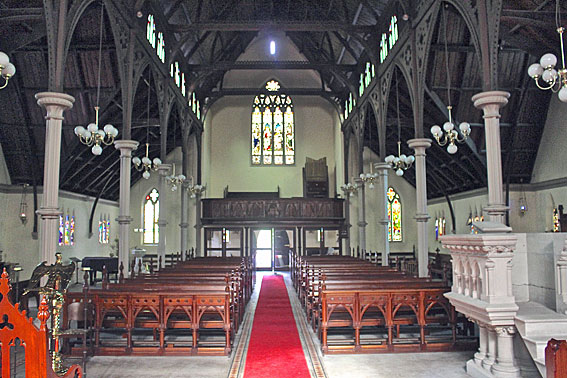
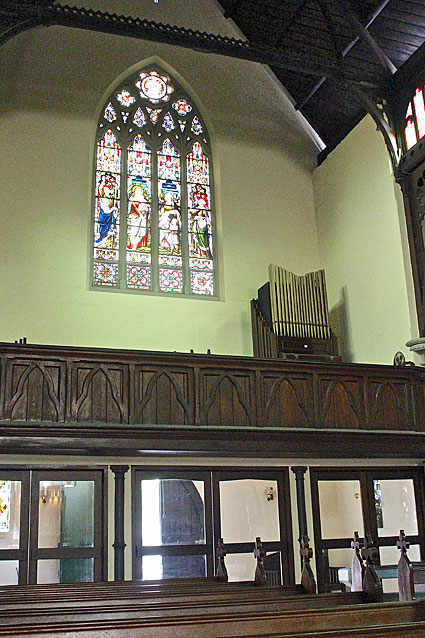
Interior of Holy Trinity Church,
showing the Positive Organ Co. organ in the gallery
[Photographs by Trevor Bunning (July 2015)]
A transposer mechanism (present 1 October 1989, but since removed) was provided with the following instructions:
To transpose - Press in the knob and turn (to the right to transpose down, to the left to transpose up) till the finger points to the required mark on the index tablet, then release knob. The pitch is normal when the word "transpose" is horizontal. THE HANDS MUST BE REMOVED FROM THE KEYS BEFORE THE TRANSPOSER IS MOVED.
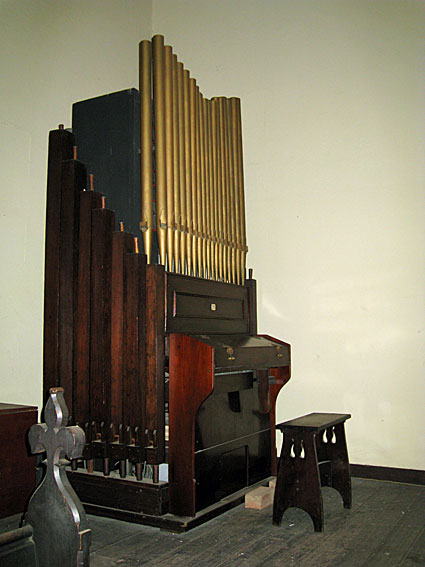
The Positive Organ Co. organ,
relocated to the gallery of Holy Trinity Church
[Photograph by Geoffrey Cox (July 2011)]
The specification is as follows:
MANUAL
| 1. 2. 3. 4. 5. 6a. 6b. 7a. 7b. |
Double Bass Melodic Viol Voix Celestes Salicional Open Diapason Gedeckt Bass Gedeckt Treble Dulcet Bass Dulcet Treble |
16 8 8 8 8 8 8 4 4 |
[to middle C] [from 6a; plays the lowest note of a chord] [treble, from middle C; plays the highest note of a chord] [gvd bass (17notes) from 6a] } }[divided at middle C] } }[divided at middle C] |
Transposer mechanism [removed in 1989 or later]
Originally footblown [apparently until 1940]
Compass: 56
Swell lever (knee-operated)
No pedals
Action: mechanical and tubular-pneumatic.31
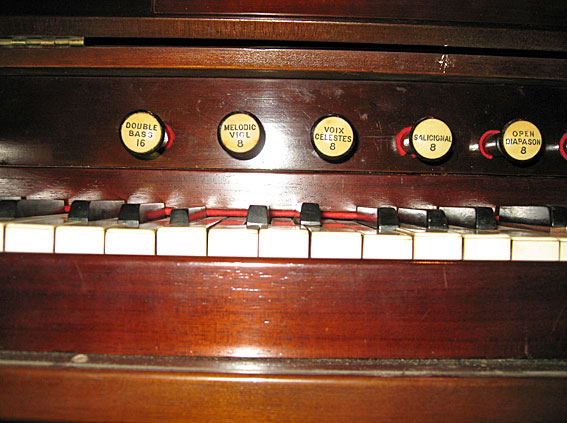
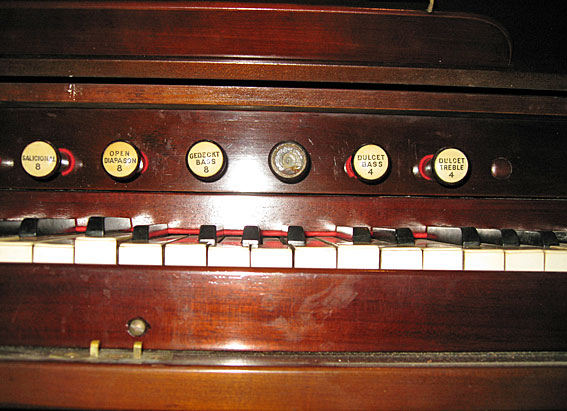
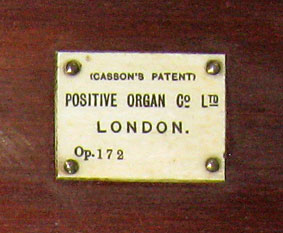
Stopknobs and builder's plate
[Photographs by Geoffrey Cox (July 2011)]
With the exception of stops 1 and 5 as listed, the pipework is entirely enclosed. The bass pipes of the Double Bass 16ft are arranged along the two sides of the organ, while the lower pipes of the Open Diapason 8ft are at the rear of the instrument.
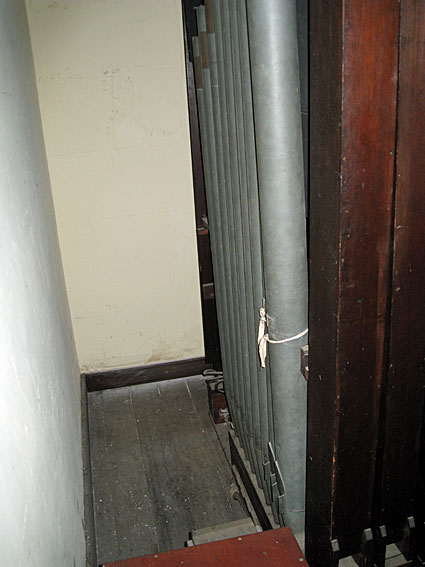
Lower pipes of the Open Diapason 8ft,
located at the rear of the organ
[Photograph by Geoffrey Cox (July 2011)]
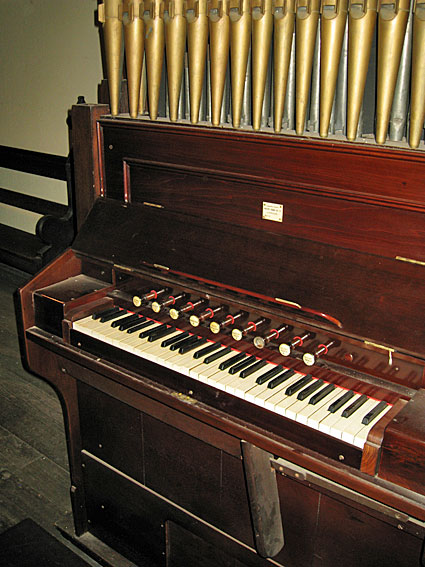

Console details, the second showing the panel
where the footblowing mechanism existed
before the electric blower was supplied in 1940
[Photographs by Geoffrey Cox (July 2011)]
_________________________________________________________________________
1 'Diary of Events' for 21 July 1877, in Pugh's Queensland Almanac ... for 1878; see also: Charles Clark & Geoffrey Cox, 'The Organs of Holy Trinity Church, Fortitude Valley, 1874-1974,' Organ Society of Queensland Newsletter, vol. 1, no. 2 (May 1974), pp. 2-4.
2 Queensland Heritage Council, Queensland Heritage Register, location 600202.
3 'Diary of Events' for 23 December 1872, in Pugh's Queensland Almanac ... for 1874.
4 The Brisbane Courier (14 February, 1874), p. 4; 'Diary of Events' for 15 February 1874, in Pugh's Queensland Almanac ... for 1875.
5 The Brisbane Courier (17 February 1874), p. 2.
6 See: St Paul's Anglican Church, East Brisbane.
7 Minutes of Parochial Council Meeting, Holy Trinity Church, Fortitude Valley (4 February 1896).
8 Minutes of Parochial Council Meeting, Holy Trinity Church, Fortitude Valley (5 March 1924).
9 Location from booklet Fortieth Anniversary of the West End Methodist Church, Nov. 8th, 1925, p. 10, and date from Minutes of Trustees Meetings, West End Methodist Church (see below) - supplied by the Methodist Historical Society, courtesy of Rev. Alan Heiner, 20 Sept. 1974.
10 Minutes of Trustees Meeting, West End Methodist Church (21 February 1908) op. cit.
11 Minutes of Trustees Meeting, West End Methodist Church (13 August 1908), op. cit.
12 The Brisbane Courier (10 December 1908), p. 2.
13 Minutes of Trustees Meeting, West End Methodist Church (31 March 1909), op. cit.
14 The Brisbane Courier (30 March 1909), pp. 2, 6.
15 Minutes of Trustees Meeting, West End Methodist Church (16 April 1909), op. cit.
16 Minutes of Parochial Council Meeting, Holy Trinity Church, Fortitude Valley (4 July 1923).
17 Minutes of Parochial Council Meetings, Holy Trinity Church, Fortitude Valley (Sept 1923, October 1923 & March 1924).
18 Centenary Booklet, Holy Trinity Parish Fortitude Valley Centenary Celebrations 1856-1956; Minutes of Parochial Council Meetings, Holy Trinity Church, Fortitude Valley (August 1924 & December 1924); The Brisbane Courier (16 June 1924), p. 3.
19 The Brisbane Courier (10 June 1924), p. 15; Collected Organ Specifications of Bernie Brohan (c.1952), and Notebooks of Mr E.R. Salisbury; confirmed by Charles Clark (organist), September 1974. The Brisbane Courier states that the action was pneumatic, whereas it is described as mechanical in all other sources.
20 Clark & Cox, op. cit; OHTA News, vol. 14, no. 2 (April 1990), pp. 27-28.
21 Date noted from plaque on console, 2003. Other details from personal communication to G. Cox from W.J. Simon Pierce, 2001.
22 Specification noted by G. Cox, 1971 & 2003; and from Recital Program (16 February 1970), supplied by Rev. Arthur Grimshaw (Rector).
23 John Maidment, 'List of Organs built by Knud Smenge Pty Ltd.' http://www.ohta.org.au/doc/Smenge.html cited September 2016.
24 Information cited on the website of Vocal Dimension Choir, Wangaratta, September 2016.
25 Personal communication from a former associate of the Wangaratta Choristers, June 2017.
26 Specification noted by G. Cox, June 2017.
27 This instrument went to the Methodist Church, West End in 1901, and then to St Philip's Anglican Church, Annerley around 1910. It was destroyed by fire in 1954.
28 Whitehouse Bros Ledger (1940-1954), p. 316.
29 Personal communication to G. Cox from Joe H. Whitehouse, jnr, c.1973.
30 Organ Society of Queensland Newsletter, vol. 18, no. 3 (December 1990), p. 52; The Organ Voice, vol. 19, no. 3 (December 1991), pp. 6-12.
31 Specification noted by G. Cox, 1972, 1989 and 2011.